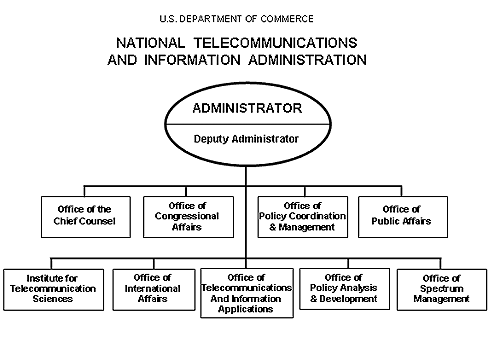The National Telecommunications and Information Administration
The NTIA is the President's principal advisor on telecommunications and information policy issues, and in this role frequently works with other Executive Branch agencies to develop and present the Administration's position on these issues. The NTIA of the U.S. Department of Commerce was established in 1978 by Executive Order 12046. Subsequently, Congress codified these functions as a result of the National Telecommunications and Information Administration Organization Act, P.L. 102538, 106 Stat.3533 (codified at 47 U.S.C. 901904).
Since its creation, the NTIA has been at the cutting edge of critical issues. In addition to representing the Executive Branch in both domestic and international telecommunications and information policy activities, NTIA also manages the federal government use of spectrum; performs cutting-edge telecommunications research and engineering, including resolving technical telecommunications issues for the federal government and private sector; and administers infrastructure and public telecommunications facilities grants. The NTIA responsibilities are divided among five line offices and four staff groups, shown below, which work together to investigate the changing field of telecommunications for America in the 21st century.

Office of International Affairs (OIA)
The NTIA Office of International Affairs develops and implements policies to enhance U.S. companies' ability to compete globally in the information technology and communications (ICT) sectors. In consultation with other U.S. agencies and the U.S. private sector, OIA participates in international and regional fora to promote policies that open ICT markets and encourage competition.
Office of Telecommunications and Information Applications
The NTIA Office of Telecommunications and Information Applications (OTIA) administers the Technology Opportunities Program (TOP), which provides matching grants to non-profit organizations and state and local governments across the United States to demonstrate innovative applications of advanced telecommunications and information technology. OTIA also manages the Public Telecommunications Facilities Program (PTFP), annually awarding grants to public broadcasting and other noncommercial entities for the purchase of telecommunications equipment to convert public television and radio stations to digital broadcasting.
Institute for Telecommunication Sciences
The Institute for Telecommunication Sciences (ITS), in Boulder, Colorado, is the research and engineering laboratory of the NTIA. ITS provides technical support to NTIA in advancing telecommunications and information infrastructure development, enhancing domestic competition, improving U.S. telecommunications trade opportunities, and promoting more efficient and effective use of the radio spectrum. ITS also serves as a principal federal government resource for investigating the telecommunications challenges of other federal government agencies, state and local governments, private corporations and associations, and international organizations.
Office of Policy Analysis and Development
The Office of Policy Analysis and Development (OPAD) is the domestic policy division of the NTIA. OPAD supports NTIA's role as principal advisor to the Executive Branch and the Secretary of Commerce on telecommunications and information policies by conducting research and analysis and preparing policy recommendations. The domestic policy office generates policies that promote innovation, competition, and economic growth for the benefit of American businesses and consumers.
Office of Spectrum Management
The NTIA Office of Spectrum Management (OSM) develops and implements policies and procedures for domestic issues regarding the use of the spectrum and assigning frequencies to the stations operated by the federal government in the United States. OSM develops long range plans and policies for the management of the spectrum; the review of federal government radiocommunication systems to make sure that sufficient spectrum is available for their compatible operation; the analysis and resolution of interference problems involving federal government radiocommunication systems; and the analysis of spectrum use in selected bands through state of the art analytic and measurement techniques.
Among OSM's functions are the processing of between 8 to 10 thousand frequency assignment actions from 56 federal government agencies each month and the maintenance of a 400,000 record data base of these actions. OSM also reviews about 90 major new federal government radiocommunication systems each year to make sure that spectrum will be available to support their operations. In addition, OSM chairs and provides staff to support the IRAC which is composed of 19 representatives from federal government agencies who advise NTIA on rules and regulations and policies for federal government use of the spectrum. Further, OSM, in close concert with the OIA, prepares Executive Branch inputs for international regulatory conferences and implements the results of those conferences. OSM provides strong technical and policy guidance for contingency and emergency planning as well as for strategic spectrum planning.
NTIA and Spectrum Management
NTIA's authority in spectrum management policy is extensive. The NTIA Organization Act clearly provides that NTIA shall assign frequencies and approve the spectrum needs of new systems for use by the federal government. Federal government users must obtain frequency assignments before they can operate transmitters.
Pursuant to delegations from the President and the Secretary of Commerce, the Administrator of NTIA is the ultimate authority in all spectrum management decisions for the federal government, except frequency assignment decisions, which can be appealed to the Director of the Office of Management and Budget. The Administrator, in turn, has delegated most spectrum management decisions to the Associate Administrator for NTIA's OSM.
The OSM formulates and establishes plans and policies that ensure the effective, efficient, and equitable use of the spectrum both nationally and internationally; develops long range spectrum plans to meet future federal government spectrum requirements including public safety; develops plans for managing radio communications during emergencies; provides public access to spectrum management information; coordinates and registers federal government satellite networks internationally; satisfies the frequency assignment needs of the federal government agencies; provides spectrum certification for new federal government agency radiocommunication systems; performs the necessary engineering analysis for evaluating and planning spectrum use; and provides the necessary automated information technology capability to perform these activities with a high degree of quality and timeliness.
